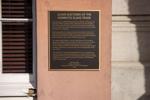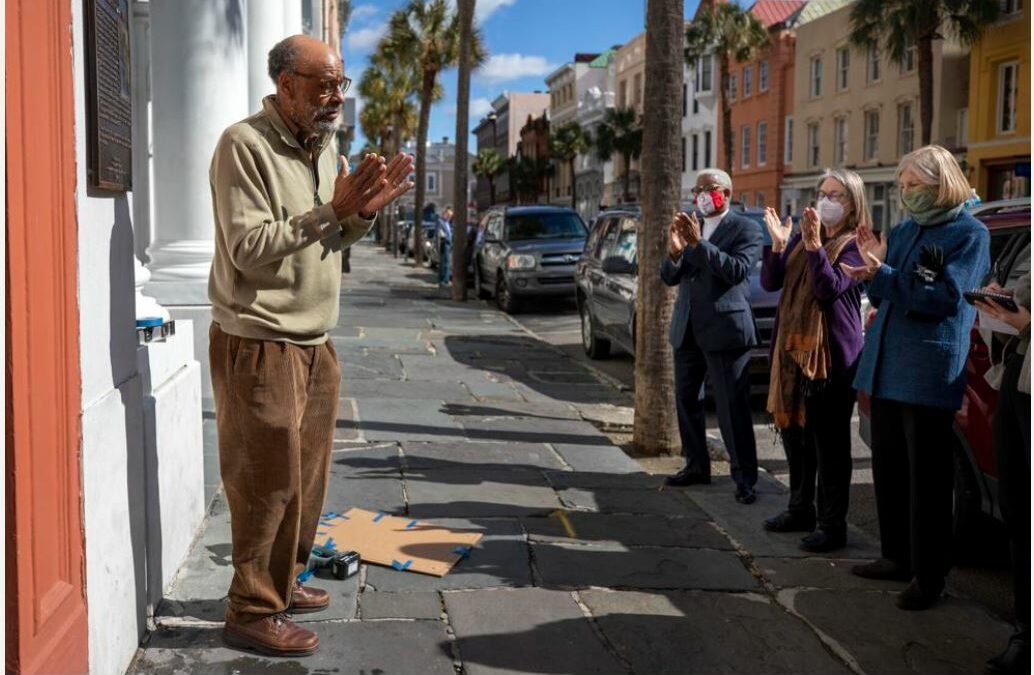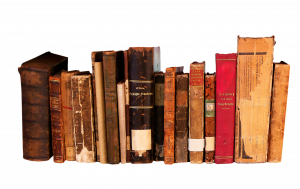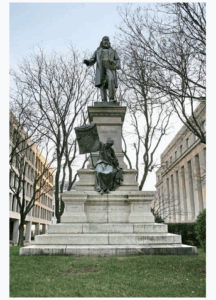SOUTH CAROLINA: Making the invisible visible: Behind the College of Charleston’s effort to highlight Black history
For Bernard Powers, Charleston is full of contradictions.
It’s a place enriched by Black history, but unless you know where to look and what you are looking at, you will miss it, he said.
Three years ago, locals and tourists would not have known that Broad Street — highly regarded as a beacon of architectural and historic preservation — was one of the busiest locations of the slave trade in Charleston. Thousands of enslaved people were sold publicly and privately at some of the buildings still standing today, including 34 Broad St.
The history of that building was uncovered by Margaret Seidler, a White Charlestonian who in 2018 discovered she was related to William Payne, the owner of one of the largest slave auction houses in the state. A marker explaining the story of the site was unveiled three years later.
In 2022, less than half a block away at 24 Broad St., College of Charleston graduate student Lauren Davila discovered another auction site: what used to be the office of the slave-trading firm Jervey, Waring and White, one of the most prominent such companies in the city.

Cars park in front of a building at 24 Broad Street, Tuesday, Nov. 12, 2024, in Charleston. The College of Charleston and Center for the Study of Slavery in Charleston sponsored a historical marker on the structure to inform people about the largest known slave auction in America in 1835, and slavery being an essential part of Charleston’s economy.
Partners of this firm arranged the sale of 600 enslaved people, the largest known transaction of human commodity in U.S. history. Davila discovered this while working on an internship assignment, which led her to find a Feb. 24, 1835 newspaper advertisement that announced the auction. A plaque commemorating this event was unveiled on Oct. 11.
Now, two plaques are visible at each Broad Street site.
These are two of many places that the College of Charleston’s Center for the Study of Slavery hopes to identify, mark and create a narrative around them that could be virtually available and accessible for both tourists and locals, said Powers, the center’s executive director.

The initiative of marking the sites was initially conceived with the creation of the center in 2018, Powers said, with the first two markers taking several years to unveil.
Powers said the center is studying other potential sites that could be marked in the future. The goal of the project is to make people understand the role slavery played in the development of the country and bring visibility to this history, he said. This effort includes the college’s faculty, student researchers, on-campus committees and community members.
“This means we have faculty members whose students are working on projects that may illuminate aspects of our mission through the research they are doing,” he said.
Charleston is growing, with about 30 people moving to the area a day from all over the country, according to the Charleston Area Convention & Visitors Bureau. Just because they now live here, does not mean they know what the city is about, Powers said. This initiative aims to educate them.
He said that for new residents to be good citizens and be involved in their communities, they need to learn about the city’s history of racism, enslavement and discrimination.
A collective effort
Powers said the center and the Committee on Commemoration and Landscapes collaborated to develop five tours for the general public called Slavery and its Legacies. The tours identify sites on campus and neighboring parts of the community. Information about these sites, which can be accessed virtually, recounts the history and experiences of Black Charlestonians through different eras.
“We want this information to be accessible to the widest possible audience,” Powers said.

The Committee on Commemoration and Landscapes was formed in 2020 after the college’s 250th anniversary. Its mission is to present a complete history of the college through signage, interior panels in campus spaces and in-person tours for visitors.
Powers said the center and the committee collaborate in an ad hoc manner, as some faculty have leadership roles in both entities.
“It’s really a network of people at every level that are working on projects that, when you put it all together, help the center accomplish its overall goal to improve the public’s knowledge of the role that slavery has played in the history of the nation and how its legacy continues to this day,” Powers said.
The Center for the Study of Slavery also collaborates with the College of Charleston Libraries, Avery Research Center and International African American Museum to facilitate an understanding of this history through public initiatives, according to the college’s website. These include digital tours and workshops for student ambassadors on how to integrate African American history on campus tours for prospective students.
In 2020, the institution started the 1967 Legacy program, named for the year when the institution became integrated. Each year, 10 students are selected for the four-year program. They have access to African American studies courses, take a first-year seminar course to study the archives of Black alumni, get support to study abroad and take advantage of internship opportunities.
In 2021, the college also spearheaded filming a 40-minute documentary, “If These Walls Could Talk,” about how enslaved Africans helped build the original campus.
Courtney Howard, chief diversity officer and vice president for diversity, equity and inclusion at the College of Charleston, said the school’s responsibility is not limited to academics; it also encourages students and members of the wider community to take an interest in Charleston’s history.

A historical marker is placed on the front of the building at 24 Broad Street, Tuesday, Nov. 12, 2024, in Charleston. The College of Charleston and Center for the Study of Slavery in Charleston sponsored the marker to inform people about the largest known slave auction in America in 1835, and slavery being an essential part of Charleston’s economy.
“It’s important that we shed light to make sure that this history is not forgotten,” she said. “If we’re not studying the impact of the presence of enslaved Africans, and then freed African Americans, or the Gullah people, our history as a state is not going to be complete.”
The push to make the African American experience visible in Charleston is part of a shared goal with local organizations that have taken steps in the same direction, Powers said. Some of these include the Charleston Gaillard Center, Preservation Society of Charleston and Emanuel AME Church.
On Oct. 21, Powers served as master of ceremonies at a College of Charleston commemoration event, where soil was collected from the site of an African American cemetery located at the Addlestone Library and Rivers Green.
The soil will be incorporated into the Anson Street African Burial Ground memorial, expected to be unveiled in spring 2025. The memorial will honor 36 Africans whose remains were discovered during renovations of the Gaillard Center.
Reckoning with the past
Howard said the college has long taken an interest in shedding light on Black history, becoming more determined to do so during the anniversary celebrations in 2020.
“We want to think about how, as an institution, we can better understand our history and be transformative for this community and the state in terms of graduating students who have an opportunity that maybe past students didn’t have: to be in a higher learning institution that has an awareness that perhaps we didn’t have in the past,” she said. “Why didn’t it happen sooner? I don’t know, but I’m glad that it happened when it did.”
The Rev. Eric Manning of Emanuel AME Church said the college is well-positioned to remind the community of the contributions of African Americans. Such work is important, he said, especially now that a political effort is underway to push this history into the shadows.
“Like anything else, we would wish and hope that more is done,” Manning said. “We should not be in the process of removing … literature or banning books, so to speak, but we should do our very best to continue to remember the contributions of everyone, regardless of how painful any history may be. It bears fact, it bears truth, and we do ourself an immense disservice when we try to remove it.”
Seidler, an author and lifelong Charlestonian who has been engaged in racial reconciliation work for years, is involved in the College of Charleston’s efforts to shed light on the African American experience in the city. Her discoveries about her family’s genealogy supported Davila’s research about the site on 24 Broad St. She and Powers advocated for the recent marker to be placed at the site.

Mayor John Tecklenburg (from left), Margaret Seidler and author Christine King Mitchell reveal one of two new historic markers on Friday, Oct. 6, 2023, in downtown Charleston. This one on Queen Street is on the north side of what once was a slave trading complex.
Seidler said she wants to seize the opportunity to be a part of the push to reckon with difficult parts of Charleston’s history.
For Seidler, there have been many moments in recent history that have caused local White residents to acknowledge Black history, such as the long development and 2023 inauguration of the International African American Museum, and the 2015 mass shooting at Emanuel AME Church, where a White supremacist killed the lead pastor and eight others at a Bible study session.
In the aftermath of the shooting, Seidler led a project meant to bring the police and regular residents together for open dialogue and trust-building.
“Conflict that’s under the table never is resolved,” she said. “If you can bring it up on top of the table, then everybody can see it, get a view of it, and then figure out how to deal with it.”
Manning said that immediately following that racially motivated attack, many members of the local community desired to come together. But what began as a sprint turned into a slow walk, he said. Nevertheless, he is encouraged by the fact that the effort has not come to a halt.
“I would hope that we always continue to remind folks of the rich and even tragic history of Charleston and ensure everyone knows and remembers all of the contributions (of African Americans), and that we keep looking for ways to move forward, and even at times pick up the pace, because we never know how much time we have left,” he said.
–postandcourier.com



